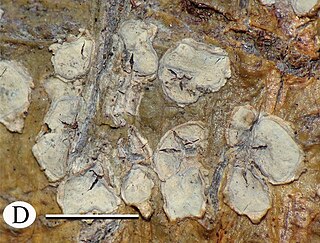
The Graphidaceae are a family of lichen-forming fungi in the order Graphidales. The family contains nearly a hundred genera and more than 2000 species. Although the family has a cosmopolitan distribution, most Graphidaceae species occur in tropical regions, and typically grow on bark.

Fissurina is a genus of lichenized fungi in the family Graphidaceae. It has about 160 species, most of which are found in tropical regions.
Chapsa is a genus of lichens in the family Graphidaceae. The genus was circumscribed by Italian lichenologist Abramo Bartolommeo Massalongo in 1860.

Nadvornikia is a genus of lichen-forming fungi in the family Graphidaceae. Species in the genus are corticolous (bark-dwelling) and crustose.

Astrochapsa is a genus of lichen-forming fungi in the subfamily Graphidoideae of the family Graphidaceae. It has 28 species. The genus was circumscribed by Sittiporn Parnmen, Robert Lücking, and H. Thorsten Lumbsch in 2012, with Astrochapsa astroidea assigned as the type species. It was segregated from the genus Chapsa, from which it differs in having a more frequently densely corticate thallus, an apothecial margin that is mostly recurved, and the almost exclusively subdistoseptate, non-amyloid ascospores.
Wirthiotrema is a genus of lichen-forming fungi in the family Graphidaceae. The genus was circumscribed in 2010 by Eimy Rivas Plata, Klaus Kalb, Andreas Frisch, and H. Thorsten Lumbsch, with Wirthiotrema glaucopallens assigned as the type species. Wirthiotrema contains species that were formerly considered part of the Thelotrema glaucopallens species group. The genus name honours lichenologist Volkmar Wirth, "for his numerous outstanding contributions to lichenology".
Rhabdodiscus is a genus of script lichens in the family Graphidaceae. It has 36 species.
Schizotrema is a genus of lichen-forming fungi in the family Graphidaceae. The genus was circumscribed in 2009 by Armin Mangold and H. Thorsten Lumbsch.
Leucodecton coppinsii is a species of corticolous (bark-dwelling) lichen in the family Graphidaceae. It is found in lowland forests of Sarawak, Malaysia.
Ocellularia rivasplatiana is a species of corticolous (bark-dwelling) lichen in the family Graphidaceae. Found in Singapore, it was formally described as a new species in 2015 by Gothamie Weerakoon and Robert Lücking. The type specimen was collected by the first author from a low-elevation primary forest in the Bukit Timah Nature Reserve. It is only known to occur at the type locality. The species epithet honours lichenologist Eimy Rivas Plata.
Pseudochapsa lueckingii is a species of corticolous (bark-dwelling), crustose lichen in the family Graphidaceae. It is known only from a single collection in São Paulo, Brazil.
Graphidales is an order of lichen-forming fungi in the class Lecanoromycetes. It contains 6 families, about 81 genera and about 2,228 species. Family Graphidaceae are the largest crustose family within Graphidales order comprising more than 2000 species, which are widely distributed in tropical and subtropical regions of the world.
Clandestinotrema is a genus of lichen-forming fungi in the family Graphidaceae. It has 17 species. They typically inhabit montane and cloud forest at higher elevations in the tropics.
Ampliotrema sorediatum, a corticolous lichen, is a species in the family Graphidaceae. It was discovered in the tropical lowland rainforest of Peru. The species epithet sorediatum refers to the unusual sorediate thallus, which distinguishes this species from its closest relative, Ampliotrema lepadinoides. The lichen was described as a new species in 2008 by lichenologists Eimy Rivas Plata and Robert Lücking.
Austrotrema is a genus of lichen-forming fungi in the family Graphidaceae. It is primarily found in the Australian-Southeast Asian region. The genus is characterized by small, pore-like apothecia with a double margin, faintly amyloid ascospores, and stictic acid chemistry. Austrotrema species grow on tree bark and have a continuous thallus with a cortex that is prosoplectenchymatous–featuring densely packed, filamentous fungal hyphae that run parallel to the surface of the lichen, creating a compact and firm texture. The genus is closely related to Thelotrema and Leucodecton, but can be distinguished from them based on molecular phylogenetic data, specific morphological traits, and its secondary chemistry. Currently, Austrotrema comprises three species.
Asteristion is a genus of lichen-forming fungi in the family Graphidaceae. It has seven species. Previously considered a synonym of either Phaeotrema or Thelotrema, molecular evidence led to its resurrection as a distinct genus. Asteristion lichens are corticolous (bark-dwelling), featuring a continuous thallus with a loose to hardened cortex and a photobiont layer containing calcium oxalate crystals. The ascomata, or fruiting bodies, are characterized by their large, often chroodiscoid appearance and the presence of distinct periphysoids. The secondary chemistry of these lichens includes major concentrations of stictic acid and minor to trace amounts of associated substances.
Jocatoa is a fungal genus in the family Graphidaceae. It contains the single species Jocatoa agminalis, a corticolous (bark-dwelling), crustose lichen that can be found in dry forests and semi-arid regions throughout Colombia, Mexico, and the United States. The genus is characterized by its simple, thin paraphysis tips and the absence of an epithecium. Named in honor of the late Professor José Castillo Tovar for his contributions to Mexican mycology, Jocatoa is distinguishable from other superficially similar genera such as Diorygma and Glyphis based on its distinctive features, chemical composition, and molecular data.
Xalocoa is a single-species fungal genus in the family Graphidaceae. The genus was circumscribed in 2013 by lichenologists Ekaphan Kraichak, Robert Lücking, and H. Thorsten Lumbsch. It contains Xalocoa ocellata, a corticolous (bark-dwelling), crustose lichen that was originally described by Elias Magnus Fries in 1831.
Gintarasia is a genus of lichen-forming fungi in the family Graphidaceae. It has seven species, all of which are found in Australia. Gintarasia species are corticolous (bark-dwelling), crustose lichens with a thelotremoid form.



